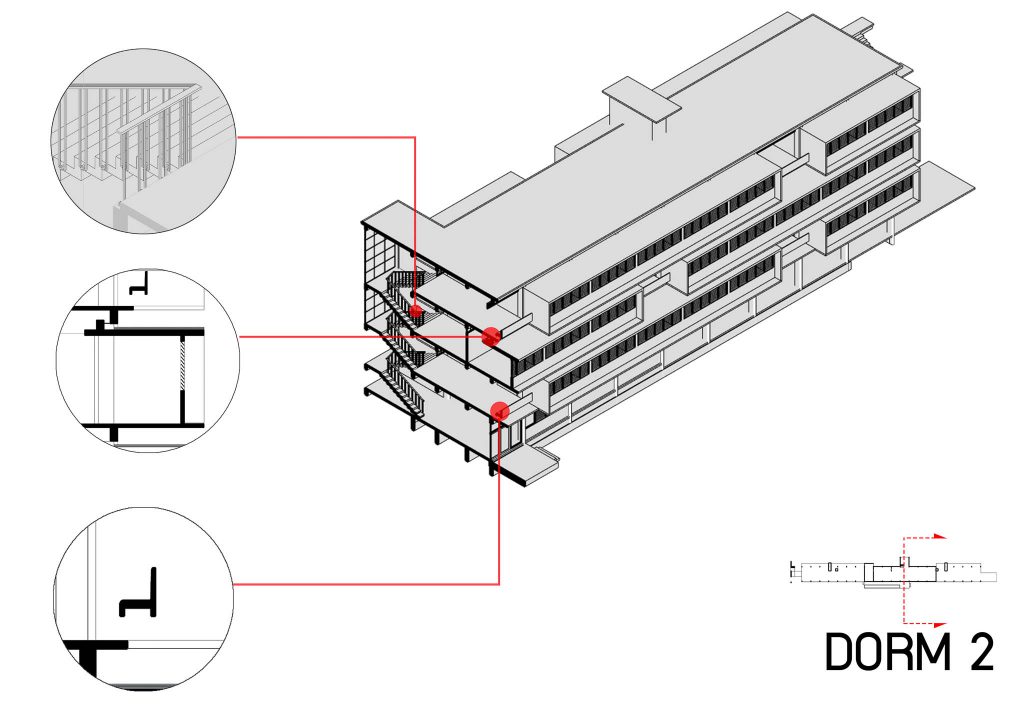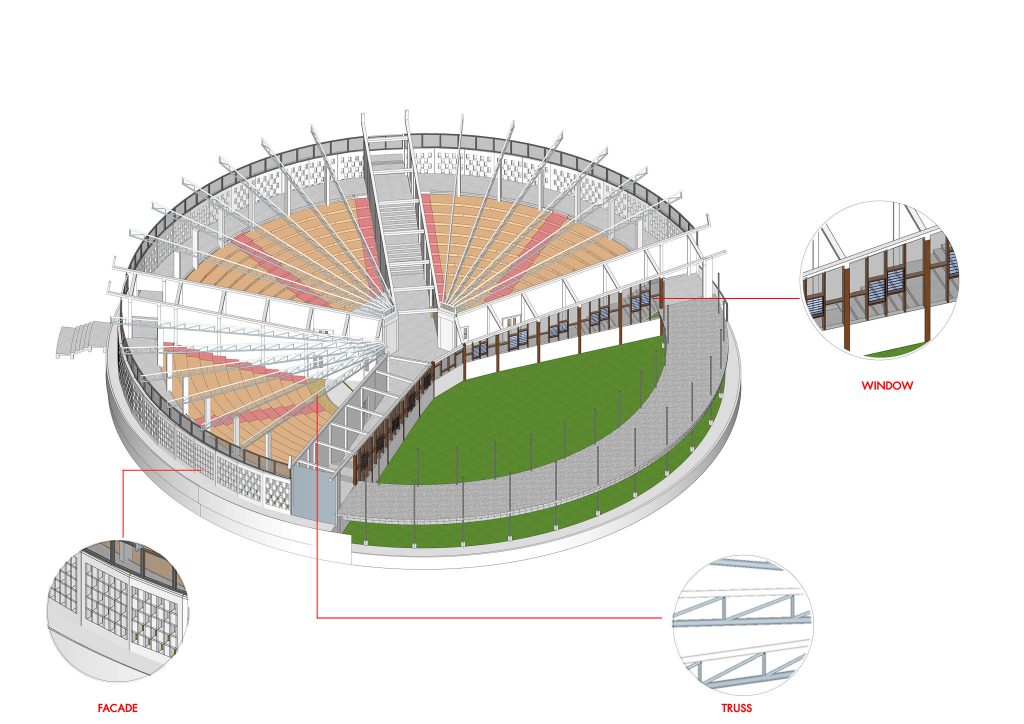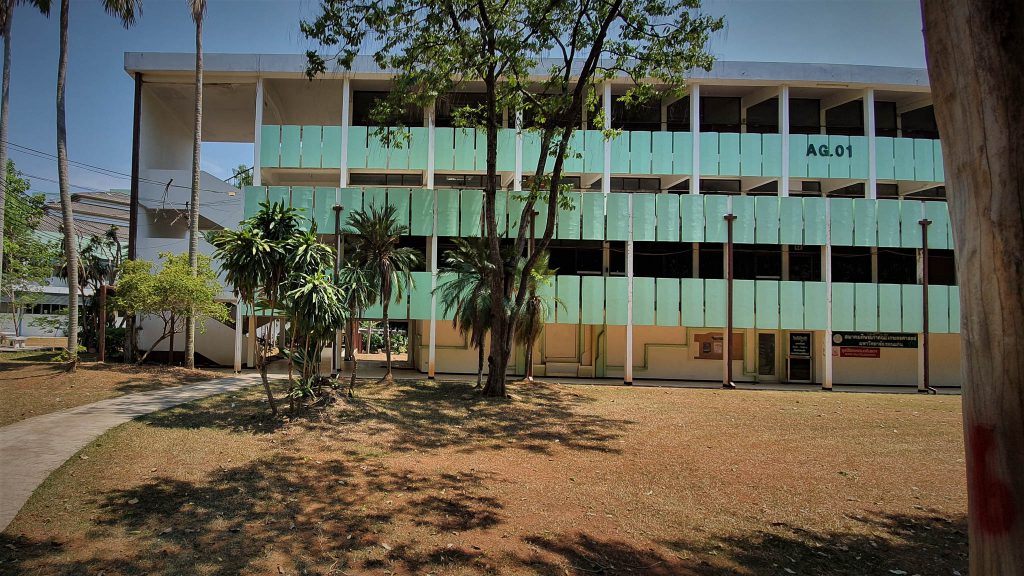Modern Architecture has been a subject of interest in Thailand for more than 70 years. The modern way of life, advances in technology, society, and growing economy have influenced the architectural practices inspired largely by foreign architects as well as a divergence in the use of natural materials in construction to reinforced concrete. Due to these factors the role of architectural design during this period is a symbol of these advance.
Text: Assoc.Prof.Dr. Nopadon Thungsakul
สถาปัตยกรรมสมัยใหม่หรือสถาปัตยกรรมโมเดิร์นอยู่ในความสนใจในประเทศไทยมานานกว่า 70 ปี นอกจากปัจจัยด้านเศรษฐกิจวิถีชีวิตสังคมสมัยใหม่แล้ว เทคโนโลยีการก่อสร้างที่เปลี่ยนจากการใช้วัสดุธรรมชาติมาเป็นคอนกรีตเสริมเหล็ก รวมถึงการปฏิบัติวิชาชีพทางสถาปัตยกรรมที่บางส่วนได้รับอิทธิพลจากการศึกษาสถาปัตยกรรมจากต่างประเทศ ก็ถือได้ว่าเป็นปัจจัยที่มีส่วนสำคัญที่ทำให้รูปแบบสถาปัตยกรรมโมเดิร์นได้รับความสนใจในประเทศไทยอย่างกว้างขวาง อาคารในยุคนี้จึงมีคุณค่าในฐานะที่เป็นตัวแทนของการเปลี่ยนแปลงที่สัมพันธ์กับความก้าวหน้าของแนวคิดในการออกแบบสถาปัตยกรรม

Photo Credit: Kunlasri Thungsakul
ปัจจุบันได้มีการดำเนินการรวบรวมข้อมูลอาคารเหล่านี้เพื่อให้เกิดการอนุรักษ์และเชื่อมโยงกับการอนุรักษ์สถาปัตยกรรมโมเดิร์นนานาชาติ (DOCOMOMO International) ภายใต้ชื่อ DOCOMOMO Thailand มีการจัดทำฐานข้อมูลอาคารที่ควรค่าแก่การอนุรักษ์หลากหลายประเภทและหนึ่งในประเภทอาคารที่ถือได้ว่าเป็นก้าวกระโดดที่สะท้อนถึงความเปลี่ยนแปลงด้านสังคมวัฒนธรรมในช่วงนั้น ได้แก่ อาคารสถาบันการศึกษา ดังที่ปรากฎว่ามีอาคารยุคโมเดิร์นที่ยังคงเหลืออยู่ในหลายสถาบัน อาทิ มหาวิทยาลัยเกษตรศาสตร์ มหาวิทยาลัมธรรมศาสตร์ มหาวิทยาลัยเชียงใหม่ มหาวิทยาลัยขอนแก่น มหาวิทยาลัยมหิดล มหาวิทยาลัย สงขลานครินทร์ เป็นต้น

Photo Credit: Assoc.Prof.Dr. Nopadon Thungsakul
สำหรับมหาวิทยาลัยในภาคอีสานอย่างมหาวิทยาลัยขอนแก่น เมื่ออาคารในยุคโมเดิร์นเริ่มเสื่อมสภาพลง เกิดภาวะคุกคามที่เสี่ยงต่อการจะถูกรื้อถอน รวมทั้งในสื่อสังคมออนไลน์ได้มีการนำเสนออาคารเหล่านี้อย่างกว้างขวาง กลุ่มศิษย์เก่าของมหาวิทยาลัยซึ่งเคยมีโอกาสเป็นผู้ใช้งานเล็งเห็นว่าอาคารเหล่านี้มีความสำาคัญในเชิงประวัติศาสตร์ที่เป็นพื้นที่หลอมรวมความทรงจำ จึงริเริ่มการเก็บรวบรวมข้อมูลและนำเสนอ เผยแพร่ต่อสาธารณะ โดยนำเสนอผ่านนิทรรศการ “โมเดิร์นในมอแรกสมัยใหม่ในที่ราบสูง: MOre MOdern Architecture in More-Kor” จัดที่ศูนย์สร้างสรรค์งานออกแบบขอนแก่น (TCDC Khon Kaen) เมื่อช่วงระหว่างวันที่ 4 พฤษภาคม – 4 กรกฎาคม 2564 ที่ผ่านมา เพื่อชวนให้เกิดการมองย้อนกลับไปดูแนวคิดด้านการออกแบบและการก่อสร้าง และการตระหนักถึงคุณค่าในการรักษามรดกทางสถาปัตยกรรมสมัยใหม่ไว้
เมืองขอนแก่นนั้นถูกวางให้เป็นเมืองศูนย์กลางของภาคอีสาน และมีจุดมุ่งหมายหลักในการพัฒนาการศึกษาเป็นส่วนสำคัญในการพัฒนาภูมิภาคตามแผนพัฒนาเศรษฐกิจและสังคม แห่งชาติฉบับที่ 1 (พ.ศ.2504 – 2509) โดยมีการสถาปนามหาวิทยาลัยขอนแก่นขึ้น เมื่อวันที่ 25 มกราคม พ.ศ. 2509 ในช่วงก่อตั้งมีการเปิดการเรียนการสอน 3 คณะวิชาคือ คณะวิศวกรรมศาสตร์ คณะเกษตรศาสตร์ คณะวิทยาศาสตร์ และอักษรศาสตร์ ถือได้ว่าเป็นคณะวิชาแรกๆ ที่มีความสำคัญในการพัฒนาภูมิภาคสู่สังคมสมัยใหม่และเทคโนโลยีที่ ก้าวหน้าในขณะนั้นการออกแบบและก่อสร้างอาคารเพื่อใช้ในการเรียนการสอนของมหาวิทยาลัยจึงถือได้ว่าเป็นการสร้างภาพตัวแทนของ “การพัฒนา” ที่ทันสมัยในภูมิภาค และก้าวหน้าทัดเทียมกับสังคมในระดับสากล

Photo Credit: Watunyoo Keawwangchai
อาคารคณะวิชาที่เกี่ยวกับด้านวิทยาศาสตร์และความก้าวหน้าของเทคโนโลยีและนวัตกรรมในการเรียนการสอน อย่าง คณะวิศวกรรมศาสตร์และคณะวิทยาศาสตร์ สถาปนิกได้ออกแบบให้สถาปัตยกรรมเป็นภาพสะท้อนของสังคมในช่วงนั้น สถาปัตยกรรมจึงมีบทบาทในฐานะที่เป็น “แบบเรียน ทางวิศวกรรม” และ “สถาปัตยกรรมแห่งวิทยาศาสตร์” (พินัย สิริเกียรติกุล, 2563) เนื่องจากการออกแบบที่
สอดคล้องกับพฤติกรรมของโครงสร้างและวิธีการก่อสร้างได้เป็นอย่างดี ตัวอย่างเช่น อาคารภาควิชาวิศวกรรมโยธา คณะวิศวกรรมศาสตร์ ที่ คุณอมร ศรีวงศ์ ทำางานร่วมกับ ศ.ดร.รชฎ กาญจนวนิชย์ ออกแบบให้เป็นอาคารช่วงกว้างโครงสร้างหลังคาเป็นโครงถักสามมิติ (3-Dimensional truss) วางพาดตลอดแนวของความกว้างช่วงเสาอาคารระยะ 9 เมตร ปลายสุดของโครงหลังคาใช้โครงสร้างแขวน (Suspension structure) หิ้วพื้นส่วนที่ยื่นออกมาเป็นระยะห่างข้างละ 3 เมตร จากแนวเสาตลอดแนวด้านยาวอาคารทั้งสองข้าง โถงเชื่อมอาคารกว้าง 12 เมตร ภายในเชื่อมด้วยทางเดินที่หิ้วโครงสร้างพื้นด้วยเส้นเหล็กตันและบันไดที่วางแบบอิสระลอยตัวในที่ว่างกลางโถง
ในขณะที่กลุ่มอาคารคณะวิทยาศาสตร์ที่ก่อสร้างเสร็จเมื่อ ปี พ.ศ. 2509 เป็นกลุ่มอาคารที่เกิดจากการจัดตั้ง คณะวิทยาศาสตร์ มหาวิทยาลัยภาคตะวันออกเฉียงเหนือ ซึ่งเป็นไปตามแผนพัฒนาภาค ปี พ.ศ. 2505-2509 กลุ่มอาคาร ประกอบด้วย อาคารเรียนและสำานักงานอธิการบดี ความสูง สองชั้น ความยาว 120 เมตร มีทางเดินเชื่อมต่อกับ อาคาร ปาฐกถา (ตึกกลม) ความจุ 500 ที่นั่ง และอาคารปฏิบัติการ (ปัจจุบันคือ อาคาร SC01) ความสูง 4 ชั้น ขนาดกว้าง 10 เมตร และยาว 60 เมตร รวมทั้งอาคารห้องปฏิบัติการทางเคมี เป็นอาคารชั้นเดียวที่หลังคาเป็นคอนกรีตโค้งพาราโบลิควางตัวต่อเนื่องกัน 5 โค้ง ปัจจุบันส่วนอาคารเรียน และสำนักงานอธิการบดีได้ถูกรื้อถอนและแทนที่ด้วยอาคารสูง 6 ชั้น เนื่องจากการความต้องการในการใช้งานอาคารกลุ่มนี้เน้นการบรรยายและการทำงานในห้องปฏิบัติการ ทีมผู้ออกแบบได้เลือกระบบโครงสร้างช่วงกว้าง วางตำแหน่งเสาไว้แนวริมอาคารทั้งหมดวางระบบคานเป็นคานหลักและคานรอง เกิดระบบการจัดวางโครงสร้างที่น่าสนใจพร้อมกับระนาบความลึกของฝ้าเพดานมีการออกแบบแผงคอนกรีตเป็นครีบกันแดดยาวตลอดแนวอาคาร รวมทั้งใช้ในการรับแสงธรรมชาติทางอ้อมสะท้อนองค์ประกอบทางสถาปัตยกรรมสู่ภายในพื้นที่ห้องปฏิบัติการ

Photo Credit: Kunlasri Thungsakul
นอกจากนี้ ยังมีอาคารในยุคแรกตั้งมหาวิทยาลัยอย่าง อาคารเรียนและปฏิบัติการ คณะเกษตรศาสตร์ (AG01-02) ออกแบบโดย คุณอมร ศรีวงศ์ เช่นเดียวกัน มีรายละเอียดทางสถาปัตยกรรมที่น่าสนใจจากการใช้แผ่นคอนกรีตสำเร็จรูปที่ทำหน้าที่เป็นแนวระเบียงกันตกและกันสาดของอาคาร เกิดเป็นจังหวะที่ปรากฏในรูปด้านนอกอาคารที่เรียบและง่าย รวมไปถึงกลุ่มอาคารสนับสนุนการเรียนการสอน อย่างหอพัก นักศึกษา เช่น หอพักที่ 1 และ 2 ที่ออกแบบให้ส่วนห้องพัก ยื่น 2 เมตร ภายนอกเน้นเป็นแนวกรอบผนังหน้าต่างโดยมีการร่นระยะกลับเข้ามาด้านใน เพื่อกันแดดกันฝนให้ช่องเปิด และหอพักที่ 3 และ 4 ออกแบบโดยสถาปนิก สมคิด เพ็ญ ภาคกุล และเฉลิมชัย ห่อนาค ซึ่งมีลักษณะของการใช้ชิ้นส่วนผนังหล่อสำเร็จรูปเป็นแผงคอนกรีตที่เป็นเสมือนบานเกล็ดขนาดใหญ่สลับกับรูปทรงระเบียงสี่เหลี่ยมที่ยื่นออกจากอาคาร
ภาพรวมของอาคารสถาบันการศึกษาอย่างมหาวิทยาลัย ขอนแก่น มีลักษณะด้านรูปแบบร่วมกับสถาปัตยกรรมสมัยใหม่หลายพื้นที่ในประเทศไทย อาคารหลายหลังเป็นผลสืบเนื่องจากการออกแบบโดยสถาปนิกคนสำคัญอย่าง คุณอมร ศรีวงศ์ ที่ได้ฝากผลงานไว้จำนวนมากในมหาวิทยาลัยส่วนภูมิภาคของประเทศ จึงอาจมีความคล้ายคลึงของรายละเอียด ทางสถาปัตยกรรมกับอาคารในมหาวิทยาลัยเชียงใหม่และ มหาวิทยาลัยสงขลานครินทร์ ถือได้ว่าเป็นพัฒนาการทางสถาปัตยกรรมที่สำคัญอีกกลุ่มในประเทศไทยที่น่าสนใจเป็นอย่างยิ่ง โดยเฉพาะการแสดงออกทางสถาปัตยกรรมที่สะท้อนถึงแนวความคิดในการให้ความสำคัญกับประโยชน์ใช้สอย การคำนึงถึงสภาพภูมิประเทศและภูมิอากาศของไทยไปพร้อมกับสุนทรียภาพอันเกิดขึ้นจากการที่องค์ประกอบทางสถาปัตยกรรมที่เป็นเปลือกนอกของอาคาร อาทิ รูปแบบของวัสดุและพื้นผิวผนังที่เกิดจากการตอบสนองความต้องการในการระบายอากาศ จังหวะเส้นสายของระเบียงแผงกันแดดและราวกันตก ความซ้ำของเส้นสายในรูปด้านจากรูปแบบของโครงสร้าง เป็นต้น

Photo Credit: Suttikarn Puttalapo
หากจะมองในประเด็นเกี่ยวกับคุณค่าสถาปัตยกรรมสมัยใหม่ในกลุ่มนี้ที่ชัดเจนคือ ด้านประวัติศาสตร์จากการเป็นหลักฐานที่บ่งบอกการเปลี่ยนแปลงด้านสังคมวัฒนธรรมและการเมืองแล้ว ในด้านการเป็นต้นแบบแห่งการเรียนรู้ด้านเทคโนโลยีและวิธีการในการก่อสร้างผ่านงานสถาปัตยกรรมในยุคนี้ก็เป็นส่วนหนึ่งที่สำคัญไม่แพ้กัน จึงถือได้ว่ามีความจำเป็นอย่างยิ่งที่จะต้องเก็บรักษาอาคารเหล่านี้เพื่อให้เป็น มรดกทางสถาปัตยกรรมของประเทศ อย่างไรก็ตาม สิ่งที่ท้าทายสำหรับสถานการณ์ปัจจุบันคือการปรับการใช้งานให้สอดคล้องกับกิจกรรมร่วมสมัยตามเงื่อนไขในการใช้พื้นที่ เพื่อรองรับการเรียนการสอนที่เปลี่ยนไปจากเดิม นอกจากนี้ยังมีประเด็นที่เกี่ยวข้องกับการให้คุณค่าในสุนทรียภาพที่แตกต่างจากแบบประเพณีเดิมและแบบร่วมสมัย ซึ่งรูปแบบและรายละเอียดของการใช้วัสดุและวิธีการก่อสร้างของอาคารในกลุ่มนี้ยังต้องการการชี้ให้เห็นความสำคัญและตระหนักถึงคุณค่า เพื่อที่จะรักษาสถาปัตยกรรมสมัยใหม่ในสถาบันการศึกษาเหล่านี้ให้คงอยู่ต่อไป

Photo Credit: Suttikarn Puttalapo
อ่านเพิ่มเติม:
เปิดคลังเอกสาร อมร ศรีวงศ์ โดย พินัย สิริเกียรติกุล – The Ten Books on Architecture by ASA
The International Working Party for Modern Move- ment (DOCOMOMO International) Thailand has been compiling ongoing data of the local changes in architecture during this period for preservation and conservation purposes including the conservation of relevant buildings, sites, and neighborhoods.
This ongoing project has compiled a database of different types of buildings worthy of preservation established during the period as well as defining architectural movements that reflected the sociocultural changes for historical, educational, and reference purposes. As such, there are Modernist buildings in Thailand that still stand in many re- gional Universities, such as Kasetsart, Thammasat, Chiang Mai, Khon Kean, Mahidol, and Prince of Songkla.

Photo Credit: Kunlasri Thungsakul
As the physical condition of modernist architectural buildings starts to deteriorate so does the potential for and the threat of demolition, Khon Kaen University in Isaan is one such example. For this reason, the University’s alumni who have used these buildings for educational purposes realize their historical and educational significance using social media to spread this message and organize an exhibition in the hope of making others aware of the importance of saving this part of history.
The exhibition was named “MOre MOdern Architecture in More-Kor” and was held at TCDC Khon Kaen from May 4 to July 4. It allowed us to look back at the Modernist ideas of architectural design and construction emphasizing the importance of preserving the cultural heritage related to this movement.
Khon Kaen had been planned to be the most important province in the northeast of Thailand. Following the first National Economic and Social Development Plan (1961-1966), the province’s fore- most objective was the development of education, as this was a vital aspect of regional development. Reinforcing this objective, Khon Kaen University was opened on January 25, 1966. The University had three original faculties: Engineering; Agriculture; Science and Liberal Arts. All these technologies were important for progressive regional development and transition into a modern society. The design and construction of the University buildings is therefore a symbol of the region’s development into a modern period showcasing the advancement of Thai society on par with those of the world.

Photo Credit: Kunlasri Thungsakul
The Faculty of Science completed in 1966 was a result of the requirement to establish such facilities in northeastern universities under the 1961-1966 Regional Development Plan. The complex consists of a two-story, one hundred- and twenty-meter- long lecture hall and rector’s office connecting to a five hundred seat auditorium. Additionally, the laboratory building, or SC01 as it is known today is a four-story, ten-meter wide, sixty-meter-long structure linked to the chemical laboratory building by walkways.
The chemical lab is a single-story, with five continuous arched parabolic concrete roofs. Here, the lecture facilities and rector’s office building have already been demolished and replaced by a new six-story building. As the emphasis in the use of these buildings is lab work and lectures, the design team utilized a wide-span structure, with supporting pillars placed at the building rims. The beam system is composed of a main beam and sub-beam, which create depth for the ceiling providing a more visually interesting structure. There are also concrete panels that run along the building’s length, shielding the building’s internals from direct sunlight while also indirectly allowing natural light to shine through, providing projected glimpses of the architectural elements into the laboratory.

Photo Credit: Watunyoo Keawwangchai
Apart from these, other buildings that were originally constructed at the university include the Faculty of Agriculture’s lecture and laboratory buildings (AG01-02). Also designed by Amorn Sriwong, these buildings have interesting architectural details with precast concrete panels used as roof guardrails and canopies offering a simplistic feature for the building’s exterior. For auxiliary buildings such as the first and second dorms, rooms are extended with a large number of windowpanes on the exterior which retract internally for protection against inclement weather and sunlight. The third and fourth dorms designed by architects Somkid Penpakkhul and Chalermchai Hornark utilize precast concrete wall panels acting as large window shutters, along with square shaped balconies extending from the structure.
In general, many of Khon Kaen University & apos;s buildings share appearances with other Modern Architecture in other parts of Thailand such as those in Chiang Mai and Prince of Songkla Universities as many of these pieces were designed by Amorn Sriwong, a prominent architect who designed many other buildings for other regional universities. These works are interesting so far as they showcase a major advancement in architecture in this country, particularly in terms of the emphasis on the utility of spaces, design consideration for Thailand’s geography and weather, and aesthetic detailing in the architectural elements for the exteriors. Those elements include cladding materials that serve to ventilate buildings, the shapes and forms of balconies, facades, and guardrails, and the repetition of lines and shapes of the structure.

Photo Credit: Kunlasri Thungsakul

Photo Credit: Assoc.Prof.Dr. Nopadon Thungsakul
It is acknowledged that there are challenges in not only preservation resourcing and application but with being able to adapt the building spaces for contemporary use following changes in edu- cation methods. However, the value of these Modern Architecture buildings lies in their historical importance. Not only are these buildings physical evidence of changes in society, culture, and politics of this period but also their value and significance as a blueprint for study in construction technologies and methodology. For these reasons alone, it is of utmost importance to pre- serve these buildings as part of the invaluable architectural heritage of Modern Architecture in Thailand.

